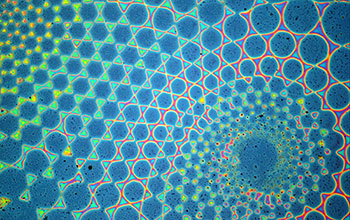Multimedia Gallery
Method allows intricate polymer brush patterns (Image 1)
A stop-flow photopatterning method developed at the University of California, Santa Barbara, allows for intricate polymer brush patterns. The new method promises to cut down processing time while adding versatility in design.
More about this image
Engineered surfaces like antimicrobial cutting boards, flame-retardant carpets and friction-resistant bearings provide extra layers of safety to items we use as well as ease of operation, preserving their quality or adding utility.
At the University of California, Santa Barbara, materials researchers are looking to greatly improve on the concept with a method of micron-scale surface chemical patterning that can not only decrease time and money spent in their manufacture, but add versatility to their design. The new method, called "sequential stop-flow photopatterning," is a platform for functionalizing and engineering surfaces with patterned polymer brushes.
The research was supported by National Science Foundation grants DMR 11-21053 and DMR 12-05194.
To learn more, see the UC-Santa Barbara news story Efficiency Plus Versatility. (Date image taken: 2015-2016; date originally posted to NSF Multimedia Gallery: Jan. 25, 2017) [See related image Here.]
Credit: Christian Pester, UC-Santa Barbara
See other images like this on your iPhone or iPad download NSF Science Zone on the Apple App Store.
Images and other media in the National Science Foundation Multimedia Gallery are available for use in print and electronic material by NSF employees, members of the media, university staff, teachers and the general public. All media in the gallery are intended for personal, educational and nonprofit/non-commercial use only.
Images credited to the National Science Foundation, a federal agency, are in the public domain. The images were created by employees of the United States Government as part of their official duties or prepared by contractors as "works for hire" for NSF. You may freely use NSF-credited images and, at your discretion, credit NSF with a "Courtesy: National Science Foundation" notation.
Additional information about general usage can be found in Conditions.
Also Available:
Download the high-resolution JPG version of the image. (1.9 MB)
Use your mouse to right-click (Mac users may need to Ctrl-click) the link above and choose the option that will save the file or target to your computer.

